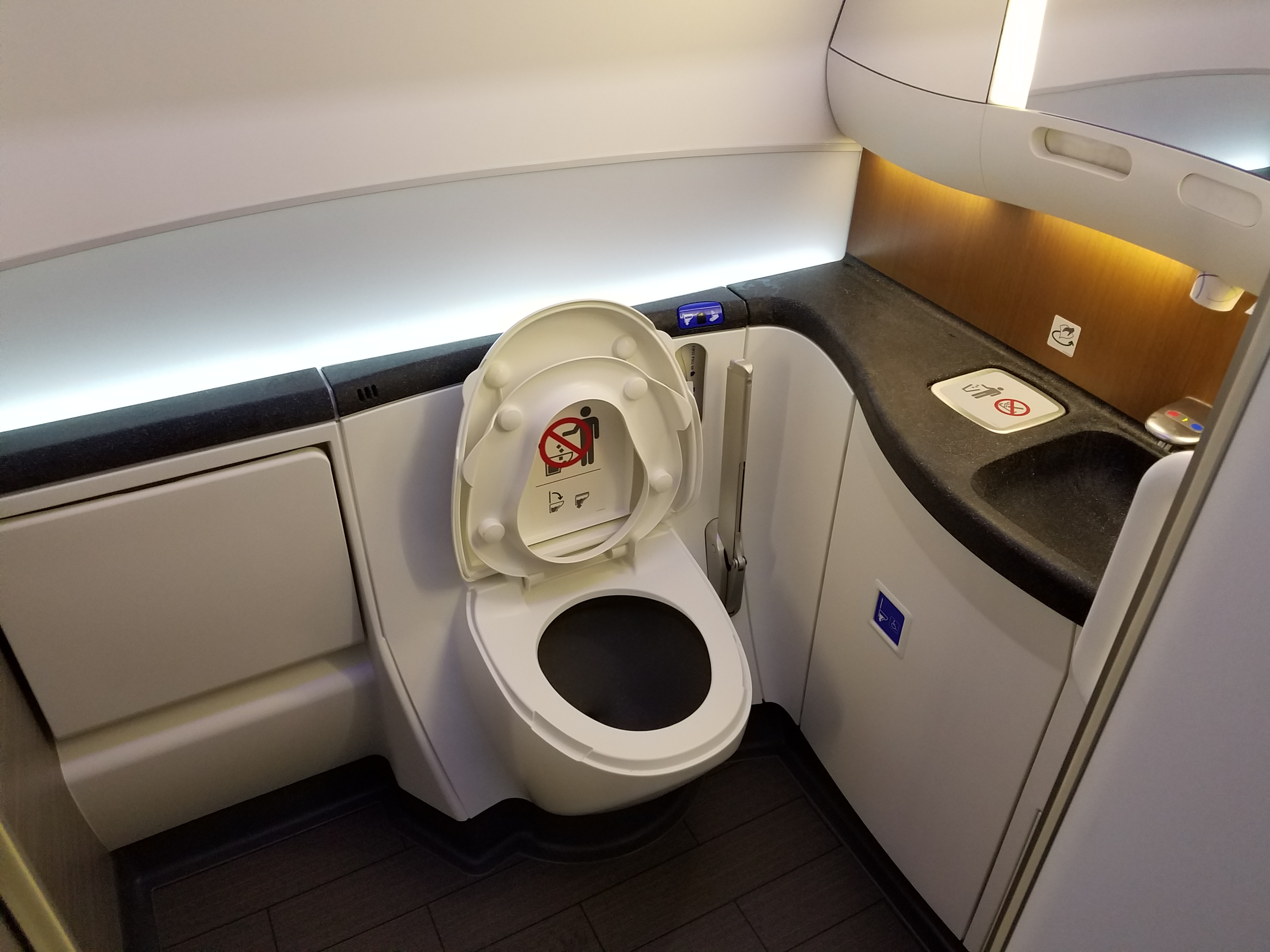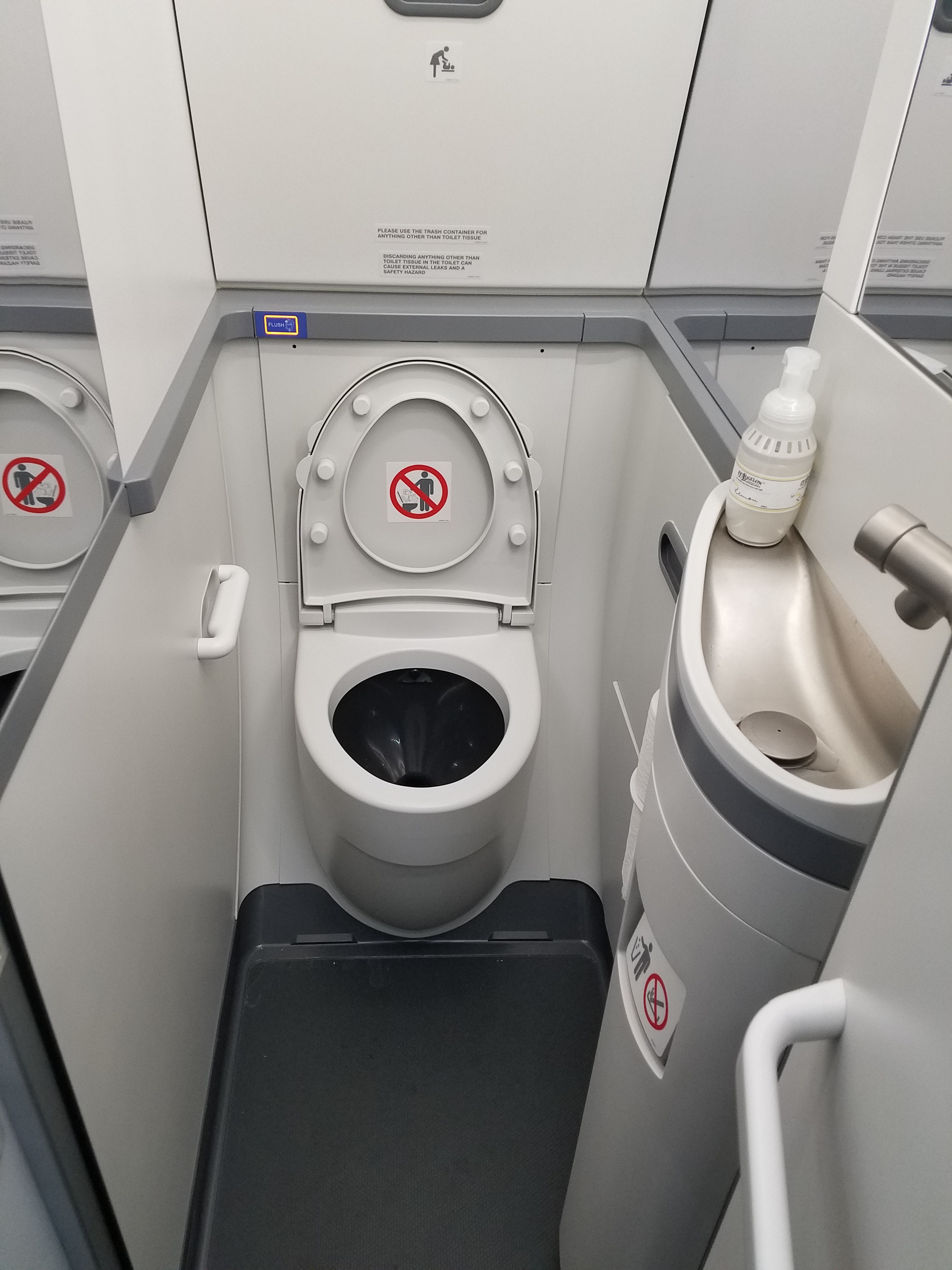The Department of Transportation has proposed a rule on aircraft lavatory sizes.
Widebody planes already have to have one larger bathroom for accessibility reasons. This rule focuses on narrowbody planes like Boeing 737s and the Airbus A320 family which have 125 or more seats. While the federal government plans to mandate larger commodes on these planes, too, they’ve proposed starting to require this for new aircraft starting in two decades.
- Smaller lavatories mean more seats. Airlines sell seats, not lavatories. And they’ve moved to ever smaller and smaller lavs (along with thinner seats) in order to fit more passengers into the same amount of plane.
- It’s hard enough for the average American (who is not small) to fit in these lavatories. Add in passengers that may need assistance, whether from another passenger or a device, and it’s nearly impossible for them to use the facilities.

American Airlines Boeing 787-8 Accessible Lavatory

American Airlines Boeing 737 Lavatory
Since narrowbody aircraft are used on the vast majority of domestic flights, and even the vast majority of domestic flights over 1500 miles (American Airlines uses Airbus A321s for its ‘premium’ cross country flights between New York and San Francisco, Los Angeles and Orange County) it’s a major challenge.
And it means that non-stop flights are generally off the table for a subset of passengers unable to use modern narrowbody bathrooms. They have to connect using flights no longer than they’re able to ‘hold it’.
Under proposed federal rules, that will be subject to challenge if taken to a final rule, we can expect this to begin to change in 20 years – but new aircraft delivered in 2041 still won’t have to have larger lavatories, and those aircraft will continue in service (based on current aircraft lifespans) into 2060 and even beyond.
- DOT began a rulemaking process on this, based on the Air Carrier Access Act, in 1990. They stood up an advisory committee in 1992.
- They propose that, for now, flight attendants should be trained in the accessibility features of lavatories, and planes with 125 seats or more would have to have at least one lavatory that includes accessible door locks, flush handles, call buttons, faucets and assist handles.
- For actual larger lavatories, here’s the proposal:
[N]ew single-aisle aircraft with 125 or more passenger seats would be required to include at least one lavatory of sufficient size to permit a qualified individual with a disability to perform a seated independent (unassisted) and dependent (assisted) transfer from the OBW to and from the toilet within a closed space. The lavatory would afford an equivalent level of privacy to the persons using the OBW as that afforded to ambulatory users. The lavatory would also include the interior accessibility improvements found in Tier 1.
Under the agreement, these improvements would be required on qualifying aircraft: (1) That were initially ordered 18 years after the effective date of the final rule implementing the agreement, or (2) that were delivered 20 years after the effective date of such a final rule; or (3) for which an application for a new type-certificate is filed after 1 year from the effective date of the final rule. The agreement does not call for retrofitting of existing aircraft to meet the new expanded size requirements, but it does require that airlines comply with the Tier 1 standards if they replace lavatories on older aircraft.
Larger lavatories and fewer seats means fewer empty seats or seats sold at deepest discount, driving down cost to consumers. Airlines argue that most passengers spend little time in the lavatory and more time in their seats, and that to hold revenue constant they’d need to take space away from the seating area to make more room in the toilet. Those who need the accessible restrooms might take that tradeoff, while others may lament it.
I’ve argued (only somewhat tongue-in-cheek) that airlines should put credit card ads in their lavatories in order to attach a revenue stream to the space and fund larger lavs.
The comment period on the Department of Transportation’s Notice of Proposed Rulemaking ends Friday, May 27. DOT will then have to consider and respond to comments, revising its rule where needed before going final. Of course some rules, like the government’s plan to regulate what you see when you search for airfare, never reach a final rule and are withdrawn (though there are rumblings that the current administration may seek to resurrect this).


I predict this will not result in larger lavatories but conversion of 2 lavatories into one. The technical design would somehow allow one toilet to slide away.
One possibility is that some galley cart storage space would be temporarily lost as the toilet is slid rearward in the fuselage. The galley carts would temporarily be place in the galley. Then push back the toilet and the cart storage space regained.
@ Derek this is already the case with Airbus’ Space Flex V2 cabin on the A32x neo series, the two bathrooms in the rear bulkhead have a swinging partition to allow for passengers in wheelchairs or with reduced mobility
@derek – Interesting idea, would never be allowed. You’re essentially storing food in a lavatory, which no one is going to be happy with.
Two solutions that I expect…
1. Boeing and Airbus will introduce new versions of their narrow-body jets that can seat no more than 124 seats. 124-seat jets are the future. Airlines will buy thousands of them. Problem solved!!!
2. Free catheters handed out to all passengers, zero bathrooms.
In fairness, this is not the airlines’ fault. The problem is that airline customers have told the airlines over and over and over again, they only care about one thing, to the exclusion of all others: the absolute, rock-bottom, cheapest ticket price. Nothing else matters to consumers, they’re not willing to pay one cent more than they have to. You know, it’s called The Wisdom of Crowds. The airlines are simply giving customers exactly what they keep demanding, and doing everything they can to cut prices.
As many airlines stopped serving in-flight food, why not transform a galley food cart into a rolling porta potty? It could be a lifesaver in accommodating disabled passengers incapable of ambulating to the toilet during their flight. Just press the cabin crew call button for service. In addition, valued elite passengers can receive upgraded two-ply toilet paper.
20 years from now Americans will need even larger bathrooms (presuming most of them can still walk, a la Wall-E)
Instead of making things bigger how about we educate a good portion of America on how to get smaller. Larger lavs should be for those who truly need them but my guess is because it’s being done to accommodate those who can’t control their caloric intake.
Just require the executive suites of airline companies to have bathrooms no larger than their smallest airplane bathroom.
You want your customers to fit in it? You fit in in CEO, CFO, and Board members!
Cue in the American right complaining thay regulation is always bad and companies being free to do whatever they want, i clouding choosing whatever toilet size they want.
Unless, of course, they are complete hypocrites (hint!)
Why?